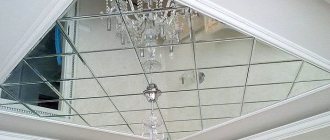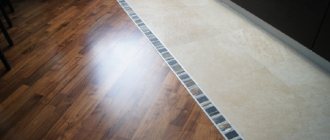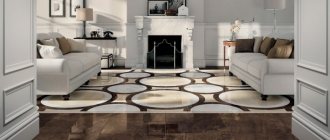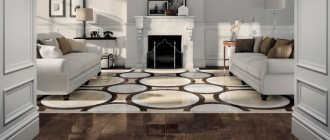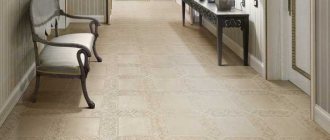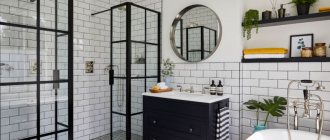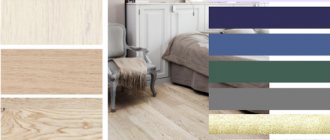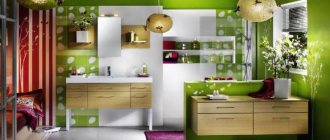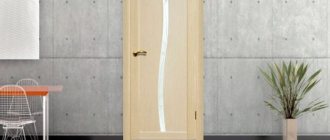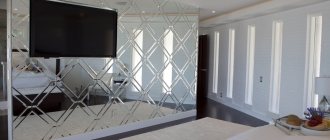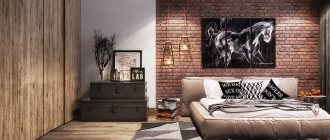What it is
A rug made from floor tiles is a decorative piece of trim that is usually combined with neutral, solid-colored elements. In fact, this is a complete external imitation of a real carpet, but the pattern is made of tiles. It can be square or rectangular in shape; inside there can be a figured pattern (panel) or a repeating pattern.
pros
- Practicality is the main advantage. Often we do not decorate the floors of complex “dirty” areas in any way - the bathroom, hallway, kitchen. A ceramic panel plays the role of decoration, but at the same time it will not get dirty like fabric, and retains all its properties: wear resistance, strength, durability, moisture resistance.
- Ease of use - the ceramic mat does not need to be knocked out, washed or constantly adjusted. Being no less beautiful, such a carpet is much easier to use.
- Zoning. Using patterned tiles, you can highlight the desired area: for example, an island or dining area in the kitchen, a toilet or sink in the bathroom.
- Originality. This design surprises and attracts attention, and is also indispensable if you want to add zest to the interior of a small bedroom or hallway where not much decor is used. And different options for this tile-carpet covering allow you to fit it into any style: from luxurious classics to practical Scandi.
Instagram @alisa_svistunova
Design: Olga Koposova
- Floor
5 types of floor tiles (and tips on what to choose)
Laying tiles
During installation, it is recommended to act quickly, but be very careful. Place the tiles inside the frame, pushing each one into place. You can use a piece of 5mm plywood as a spacer, but special tile crosses will ensure you have perfectly placed grout lines. Lay the tiles one by one, starting at the top corner and working downwards. Then fill the top row to the right corner. This will ensure that the tiles are evenly distributed throughout the area of the mat. Continue filling the mat with tiles until they are all laid.
Choosing material
Floor tiles can be made from different materials.
Cement tiles
Durable and dense material, which is made by pressing. Then the resulting products are kept in water and gain strength over a long period of time. Another significant plus is environmental friendliness. The material does not emit any harmful substances due to the fact that it hardens naturally and without exposure to high temperatures.
Ceramics
The most common type with a large selection of technical characteristics, shapes, sizes and colors. It is made from a mixture of various materials (the most popular option is clay and quartz sand) under the influence of high temperatures, then cools and hardens.
Porcelain tiles
Porcelain tiles are the most durable and durable tile covering. Like ordinary ceramics, it is made from a binder mixture and fired, and then further pressed. Usually produced in medium or large format in the form of seamless slabs, it is often used not only in the bathroom or hallway, but also in residential areas.
Instagram @galina.z_design
Instagram @erinsander
Unsplash
- Decoration Materials
How and with what to cut porcelain tiles at home: 4 proven methods
What are the patterns?
With the help of ceramic finishing, different patterns are painted on it. Let's look at the most common ones.
Geometric pattern
The simplest design option is a combination of squares, rectangles, hexagons or circles. This pattern immediately attracts attention, so it is desirable that the remaining elements of the interior be neutral colors, plain or with a discreet ornament.
Instagram @sultanovart
Instagram @lena_quart
Instagram @ibbdesign
3D effect
Essentially the same geometric pattern, but with a three-dimensional effect. Great for modern and Scandinavian interiors and also adds volume to small spaces.
Instagram @julia.design_home
Instagram @int2architecture
Patchwork
Initially, the term “patchwork” was used to describe the patchwork technique, but very soon it went beyond needlework, and colorful patchwork prints began to be used in a variety of areas, including decoration.
Today you can choose any size, color and variation of this ornament. Since each piece of tile is a separate pattern, it is much easier to create such a carpet than a complex panel with a center of the composition and axes of symmetry.
Instagram @roszczewska_wnetrza
Instagram @maylizgood
Instagram @orient_concepttile
Oriental motifs
Metlah, Moroccan, Indian patterns, Turkish cucumbers - all this refers to oriental prints. These are complex seamless patterns, most often in rich colors. Such ornaments will fit well into styles with notes of eclecticism: for example, boho or eco, but will also find their place in modern and neoclassical interiors.
Instagram @bychkovi_design_interior
Instagram @mzenova.design
Photo: @Unsplash
- Floor
The best options for combining laminate and tiles on the floor in different rooms (60 photos)
DIY tile rug
Necessary materials:
- a small sheet of drywall;
- ceramic tile;
- wooden plank for frame;
- universal cement;
- grout solution;
- construction adhesive;
- tile spacers;
- spray paint.
Required tools:
- steel spatula;
- sponge for removing grout from tiles;
- sponge for grouting;
- bucket;
- roulette;
- a circular saw;
- an angle grinder with a stone wheel or utility knife;
- clips or masking tape.
